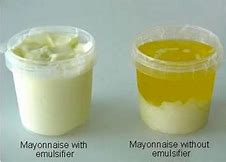Top types of emulsifiers and why they matter
Emulsifiers: Trick Ingredients for Attaining Completely Mixed Formulas
Emulsifiers play an essential duty in developing stable mixes of immiscible fluids, such as oil and water. Their one-of-a-kind properties permit them to minimize surface stress, which is important for harmony in different formulations. Understanding the distinctions between all-natural and synthetic emulsifiers can influence item top quality significantly. As markets progressively look for to boost texture and shelf life, the option process for the right emulsifier becomes vital. What elements should be considered in this essential option?
Comprehending Emulsifiers: What They Are and Just how They Function
Although emulsifiers might appear like a simple enhancement to formulas, they play an essential role in maintaining mixtures of ingredients that commonly do not blend well, such as oil and water. These substances work by lowering surface tension at the user interface in between immiscible liquids, allowing them to blend more uniformly. Emulsifiers consist of both hydrophilic (water-attracting) and lipophilic (oil-attracting) homes, which allow them to secure themselves at the boundary of both phases. By doing so, they develop a safety obstacle that avoids the droplets of one fluid from coalescing into bigger masses, thereby maintaining a secure emulsion. The efficiency of an emulsifier depends on its molecular framework, which affects its ability to maintain combinations. In different applications, from foodstuff to cosmetics, emulsifiers guarantee a consistent structure and appearance, improving both capability and customer allure. Their relevance can not be overemphasized in attaining well-blended formulations.
Sorts of Emulsifiers: Synthetic vs. all-natural
Emulsifiers can be generally categorized right into 2 kinds: natural and artificial, each offering unique benefits and applications. All-natural emulsifiers, originated from plant or pet resources, consist of casein, lecithin, and gum tissue arabic (emulsifiers). These emulsifiers are often favored in clean-label and organic items as a result of their marginal handling and biocompatibility. Their mild nature makes them suitable for delicate solutions, particularly in food and cosmetics

On the other hand, artificial emulsifiers such as mono- and diglycerides, and polysorbates are manufactured with chemical procedures. They are commonly used in industrial applications due to their stability and performance in producing emulsions. Synthetic emulsifiers typically exhibit superior efficiency in extreme conditions, such as heats or varying pH degrees. The selection between artificial and natural emulsifiers largely depends on the details solution demands, regulative considerations, and customer choices, affecting their efficient application in various sectors.
Features of Emulsifiers in Food and Cosmetic Formulas
The role of emulsifiers prolongs beyond mere stablizing; they are essential in attaining the desired appearance, texture, and shelf life of food and cosmetic products. In food formulas, emulsifiers help blend oil and water, producing consistent and smooth textures vital for sauces, dressings, and dairy items. They minimize surface area tension, improving the stability of emulsions, which avoids separation and extends quality.
In cosmetics, emulsifiers assure that components, such as oils and water, mix effortlessly, offering a pleasant feel and improving application. emulsifiers. They add to the item's thickness and spreadability, important for creams, lotions, and lotions. Additionally, emulsifiers can encapsulate energetic ingredients, improving their distribution and performance in formulations. By regulating appearance and boosting sensory qualities, emulsifiers play an important duty in conference consumer expectations in both food and cosmetic markets, ensuring products are not only appealing but additionally functionally reliable
Picking the Right Emulsifier for Your Item

Additionally, the target application-- whether for food, cosmetics, or pharmaceuticals-- will certainly affect the option. Food-grade emulsifiers should comply with safety laws, while aesthetic emulsifiers might require skin compatibility. Assessing aspects such as HLB (Hydrophilic-Lipophilic Balance) aids in forecasting emulsifier habits in certain formulas. Ultimately, a detailed assessment of both practical needs and governing factors to consider is vital to select the most effective emulsifier, making certain the last product satisfies the preferred quality and security criteria.

Tips for Effective Solution Formation and Stability
Attaining effective solution formation and stability needs mindful focus to numerous vital variables. The selection of emulsifier plays a crucial function; it should be suitable with the oil and water phases to guarantee effective stabilization. Second, the ratio of oil to water should be balanced, as an incorrect proportion can cause instability. Third, the mixing procedure must be controlled; high shear blending click to read more can aid attain smaller bead sizes, enhancing stability.
Temperature likewise influences solution stability; preserving ideal temperature levels throughout formula prevents premature splitting up. More Bonuses Furthermore, integrating stabilizers such as thickeners can better boost thickness, decreasing the chance of phase splitting up. Ultimately, carrying out extensive stability tests after solution will help determine prospective issues, enabling adjustments before last production. By adhering to these guidelines, formulators can accomplish regular and reputable solutions that keep their preferred residential properties gradually.
Often Asked Concerns
Can Emulsifiers Be Utilized in Vegan Formulations?
Yes, emulsifiers can be made use of in vegan formulations. Lots of plant-based emulsifiers, such as lecithin from soy or sunflower, supply efficient blending without animal-derived components, making them appropriate for a variety of vegan items.
What Prevail Irritants in Emulsifiers?
Typical allergens in emulsifiers include soy, dairy products, and eggs, as particular emulsifiers are stemmed from these sources. In addition, some individuals might react to chemicals or ingredients made use of together with emulsifiers in various solutions.

Exactly How Do Emulsifiers Impact Service Life of Products?
Emulsifiers improve product stability by preventing splitting up of active ingredients, thereby extending service life. They minimize wasting brought on by microbial growth and oxidation, resulting in extended quality and enhanced high quality in numerous food and cosmetic solutions.
Are There Any Type Of Wellness Problems Connected With Emulsifiers?
Research study indicates potential wellness issues associated with emulsifiers, including digestive tract microbiome alterations and swelling. While regulatory bodies typically deem them risk-free, continuous researches continue to discover long-lasting effects on health and wellness and overall wellness.
Can Emulsifiers Improve Taste or Scent in Formulations?
Emulsifiers can improve taste and aroma in formulas by boosting active ingredient dispersion and stability. This causes a more uniform product, permitting flavors to combine successfully, inevitably leading to a much more enjoyable sensory experience for customers.
Emulsifiers may appear like an easy addition to solutions, they play an important role in supporting mixtures of active ingredients that generally do not mix well, such as oil and water. In food formulations, emulsifiers help mix oil and water, producing smooth and uniform textures essential for find sauces, dressings, and milk items. Food-grade emulsifiers must abide with security laws, while aesthetic emulsifiers might require skin compatibility. Common irritants in emulsifiers consist of soy, dairy products, and eggs, as certain emulsifiers are derived from these resources. Emulsifiers can improve taste and scent in solutions by improving active ingredient dispersion and security.